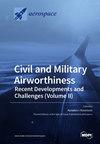An Engine Deterioration Model for Predicting Fuel Consumption Impact in a Regional Aircraft
IF 2.1
3区 工程技术
Q2 ENGINEERING, AEROSPACE
引用次数: 0
Abstract
A deterioration cycle model is presented, designed to consider the turbomachinery efficiency losses that are expected during real engine in-service operations. The cycle model was developed using information from practical experience found in the literature to account for both short- and long-term deterioration effects; the former occurring during the first flight cycles, the latter due to regular in-service operation. This paper highlights the importance of analyzing the inter-turbine temperature margin () to track engine deterioration to determine the extent of an in-service engine life. The proposed model was used to assess the and fuel consumption impact in the CRJ-700 regional aircraft (powered by two CF34-8C5B1 engines) for three representative missions: short (0.4 h), average (1.4 h), and long (2.5 h), considering different levels of engine deterioration, from the new engine level up to fully deteriorated. The fuel consumption at the new engine level (zero deterioration) was validated against a real-time engine model embedded in a Level-D flight simulator, the so-called Virtual Research Flight Simulator located at the Laboratory of Applied Research in Active Control, Avionics, and AeroServoElasticity. The errors found in this validation for the trip mission fuel consumption in the short, average, and long missions were −3.6, +0.9, and +0.6%, respectively. The cycle model predictions suggest the for a new engine is 55.2 °C, whereas for a fully deteriorated engine, it is 26.4 °C. Finally, in terms of fuel consumption, the results presented here show that an average CF34-8C5B1 engine shows an increase in the cumulative fuel consumption of 2.25% during its life in service, which translates to a 4.5% impact in aircraft fuel consumption.用于预测支线飞机耗油影响的发动机劣化模型
本文介绍了一种劣化周期模型,旨在考虑实际发动机在役运行期间预计出现的涡轮机械效率损失。该循环模型是利用文献中的实际经验信息开发的,以考虑短期和长期的劣化效应;前者发生在第一个飞行循环期间,后者则是由于正常的在役运行造成的。本文强调了分析涡轮间温度裕度()对跟踪发动机劣化以确定在役发动机寿命的重要性。所提出的模型被用于评估 CRJ-700 支线飞机(由两台 CF34-8C5B1 发动机提供动力)在三个代表性任务中的油耗影响:短期(0.4 小时)、平均(1.4 小时)和长期(2.5 小时),并考虑了从新发动机水平到完全劣化的不同发动机劣化水平。新发动机水平(零劣化)下的燃油消耗与嵌入 D 级飞行模拟器(即位于主动控制、航空电子设备和航空伺服弹性应用研究实验室的所谓虚拟研究飞行模拟器)的实时发动机模型进行了验证。在这次验证中发现,短期、平均和长期飞行任务的行程油耗误差分别为-3.6%、+0.9%和+0.6%。循环模型预测表明,新发动机的温度为 55.2 °C,而完全老化的发动机的温度为 26.4 °C。最后,在油耗方面,本文提供的结果表明,一台普通的 CF34-8C5B1 发动机在其服役期内的累计油耗增加了 2.25%,这相当于飞机油耗增加了 4.5%。
本文章由计算机程序翻译,如有差异,请以英文原文为准。
求助全文
约1分钟内获得全文
求助全文
来源期刊

Aerospace
ENGINEERING, AEROSPACE-
CiteScore
3.40
自引率
23.10%
发文量
661
审稿时长
6 weeks
期刊介绍:
Aerospace is a multidisciplinary science inviting submissions on, but not limited to, the following subject areas: aerodynamics computational fluid dynamics fluid-structure interaction flight mechanics plasmas research instrumentation test facilities environment material science structural analysis thermophysics and heat transfer thermal-structure interaction aeroacoustics optics electromagnetism and radar propulsion power generation and conversion fuels and propellants combustion multidisciplinary design optimization software engineering data analysis signal and image processing artificial intelligence aerospace vehicles'' operation, control and maintenance risk and reliability human factors human-automation interaction airline operations and management air traffic management airport design meteorology space exploration multi-physics interaction.
 求助内容:
求助内容: 应助结果提醒方式:
应助结果提醒方式:


